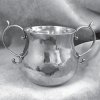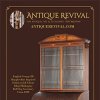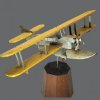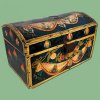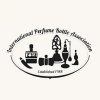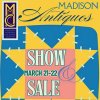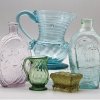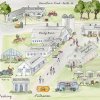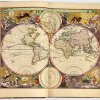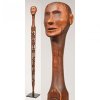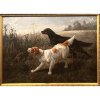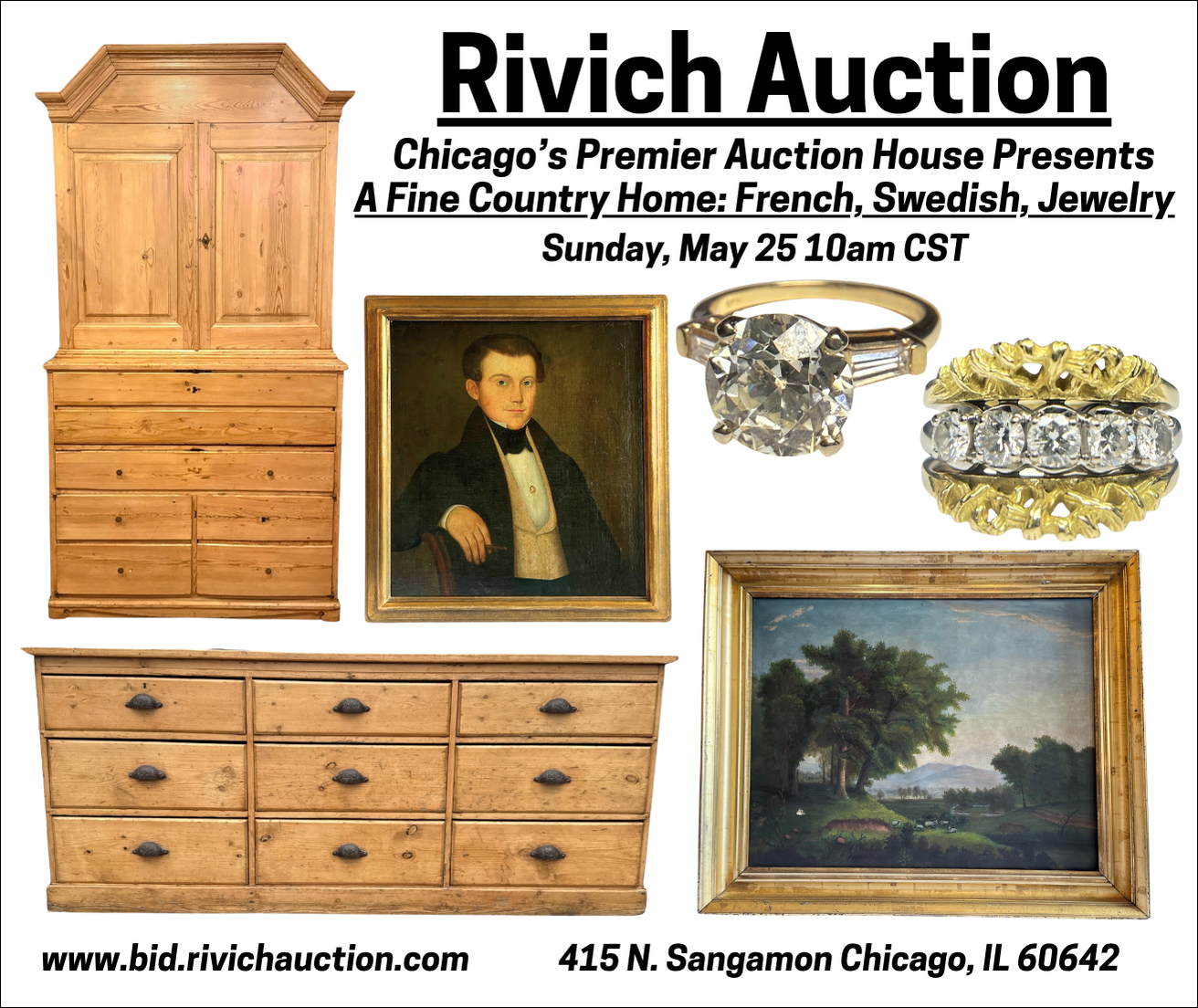Portrait by Ammi Phillips Leads Americana Auction
January 20th, 2017
Christie’s, New York City
Photos courtesy Christie’s
When people walked into Christie’s salesroom on the morning of January 20, Barack Obama was still president. By the time they walked out hours later, Donald Trump had taken the oath of office.
Divided America outside. Divided Americana inside.
The headliners did just fine, but middle-level antiques sometimes struggled with a thin level of support. The long Friday sale brought in $5,037,025 (includes buyers’ premiums)—$1,242,750 for a selection of Outsider art put together by specialist Cara Zimmerman that was 78% sold by lot, and $3,794,275 for various owners’ Americana, 80% sold by lot.
“I think the numbers speak for themselves,” said John Hays, deputy chairman at Christie’s. “There were definite high notes, and a few pieces performed very well. There was a lot of material that sold where the estimates were. We know where the market is now.
“When we sell things in the eightieth percentile overall, it tells me that we were spot-on…. Our assessment is that the market is resilient. It has found a new level, and it should give confidence to people to consign.
“When something did well, it’s usually because it was rare or had a great surface. The bottom half of the market is still tough sledding, but when was it otherwise?”
The Americana was led by a circa 1829 oil on canvas portrait by Ammi Phillips (1788-1865) of Mary Margaret Deuel, daughter of Catharine and Samuel Deuel of Dutchess County, New York. Estimated at $100,000/150,000, it sold for $391,500 to New York City dealer Leigh Keno, sitting with clients. That’s the fifth-highest price ever paid for a portrait by Ammi Phillips.

This 30" x 24" oil on canvas portrait by Ammi Phillips (1788-1865) of Mary Margaret Deuel, circa 1829, estimated at $100,000/150,000, sold for $391,500 to Leigh Keno, sitting with clients. The painting descended from the sitter in the Deuel family until it was sold on October 29, 1982, for $99,000 at Robert W. Skinner, Inc., Bolton, Massachusetts. Mary Margaret Deuel was the daughter of Catharine and Samuel Deuel of Dutchess County, New York.
The painting descended in the Deuel family until it was sold on October 29, 1982, for $99,000 at Robert W. Skinner, Inc., Bolton, Massachusetts. Sotheby’s offered it on September 30, 2010, with a much higher estimate ($500,000/700,000), but it failed to sell. Phillips’s portrait of Mary’s father, Samuel, sold at Neal Auction Company for $1195 in March 2010. It too had been once bought in; Neal had tried it with a $5000/7000 estimate in November 2009, but it had failed to sell.
Before buying the Ammi Phillips painting, Keno paid $150,000 for a 30" x 23" oil on canvas portrait of a boy holding an apple, attributed to John Brewster Jr. (1766–1854), ex-Hirschl & Adler Folk.
“The bright light folk art did astonishing,” said Hays. “The folk art goes to the real underlying theme, and that is, paint really sold—paintings, paint on canvases, paints on surfaces.”

These 1740-55 chairs, attributed to William Savery, were sold back-to-back, and in a departure for a New York City salesroom were sold as “choice.” (The auctioneer gave the winner of the first chair the option to buy the second chair at the same price with no competition.) The first one brought $118,750 from a Philadelphia collector sitting with dealer Philip Bradley, underbid by Chalfant. When given the opportunity, the collector declined to buy the second chair at the same price. “We will bid,” he said. That decision cost him an extra $6250; the second chair sold for $125,000, underbid by the trade.
A pair of 1740-55 chairs attributed to William Savery were sold back-to-back and in a rare departure for a New York City salesroom were sold as “choice” or “parcel.” (Christie’s gave the winner of the first chair the option to buy the second chair at the same price with no competition.) The first chair brought $118,750 from a Philadelphia collector sitting with Philip Bradley of Philip H. Bradley Co., underbid by Skip Chalfant of H.L. Chalfant. When given the opportunity, the collector declined to buy the second chair at the same price. “We will bid,” he said. That decision proved costly to him; the next chair brought an extra $6250 when it went to him for $125,000, underbid by the trade.
“We have done this [selling lots parcel] several times before. It empowers the buyer of the first chair, and it added a little bit of fun to the selling,” said Hays. It also allowed a museum to buy only one chair if it was interested, even though chairs at this level are usually sold in pairs. “It’s nice to show the market that we care about keeping things together, but it also allows the consignor to realize the most money possible. If a dealer bought the pair and then sold each to a different museum, the consignor doesn’t benefit. It allowed the consignor to have the best of both worlds,” said Hays.
 A selection of Colonial silver from the Wunsch collection had mixed results. Ten lots were offered, and three were passed. The lots were led by a coffeepot by John Blowers of Boston, circa 1735, at $32,500 and by a silver teapot marked by Samuel Casey of Exeter and South Kingston, Rhode Island, at $25,000. A rare pair of candlesticks by Simeon Soumaine, 1730-50, estimated at $100,000/200,000, failed to sell, as did a pair of circa 1770 silver sauceboats marked by Stephen Emery of Boston, estimated at $40,000/60,000, and a pair of silver braziers marked by John Burt of Boston, 1724, estimated at $100,000/200,000.
A selection of Colonial silver from the Wunsch collection had mixed results. Ten lots were offered, and three were passed. The lots were led by a coffeepot by John Blowers of Boston, circa 1735, at $32,500 and by a silver teapot marked by Samuel Casey of Exeter and South Kingston, Rhode Island, at $25,000. A rare pair of candlesticks by Simeon Soumaine, 1730-50, estimated at $100,000/200,000, failed to sell, as did a pair of circa 1770 silver sauceboats marked by Stephen Emery of Boston, estimated at $40,000/60,000, and a pair of silver braziers marked by John Burt of Boston, 1724, estimated at $100,000/200,000.

This silver wine cup, Boston, circa 1660, is marked by John Hull and Robert Sanderson and engraved “Property / of the / Old South Church.” It went to a phone bidder for $150,000.
Four lots of silver from Boston’s Old South Church were offered. The grouping was led by a silver wine cup by John Hull and Robert Sanderson, circa 1660, 7" high, marked “Property / of the / Old South Church.” It sold for $150,000 to a phone bidder. A circa 1715 silver beaker with the mark of John Coney of Boston, 4¼" high, was also engraved “Property / of the / Old South Church.” Estimated at $20,000/30,000, it sold to an order bidder for $27,500. A circa 1715 silver beaker, 5¾" high, by John Coney went to Paige Trace of Portsmouth, New Hampshire, for $20,000 (est. $20,000/30,000). A silver wine cup with the mark of Jeremiah Dummer of Boston, circa 1705, also engraved “Property / of the / Old South Church” and 8 3/8" tall, brought $47,500 (est. $30,000/50,000) from a phone bidder.
Jeremiah Dummer (1645-1718) was America’s first native-born silversmith. In 1659 he began his apprenticeship with émigré John Hull. Dummer himself trained John Coney, with whom he maintained a lifelong friendship, according to the catalog.
A pair of standing cups of the same form, but with the elaborate Stoughton coat of arms as well as the mark of Dummer, was sold as property of the First Parish Church, Dorchester, Massachusetts, at Sotheby’s New York City, January 2012, for $1,082,500.
Seventeen lots that were ex-Mrs. J. Insley Blair (Natalie Knowlton Blair, 1883-1951) fared a little better; 12 sold. The lots were led by a Philadelphia 1740-60 walnut compass-seat side chair, 42½" high, estimated at $20,000/30,000, that sold to a phone bidder for $50,000, underbid by dealer James Kilvington of Dover, Delaware.
Kilvington bought the next-highest ex-Blair lot, a 93½" x 35½" x 19¼" Philadelphia Chippendale carved and figured walnut corner cabinet dating from the last quarter of the 18th century. He paid $37,500.
“The Outsider art was heroic,” said Hays, referring to the $1.2 million total. Outsider art featured in a separate catalog. William Edmondson’s limestone and mortar Lion, circa 1937, topped at $511,500 to collector Jerry Lauren, bidding in the room. Lion descended in the family of Alfred and Elizabeth Starr, who were early collectors and supporters of Edmondson, an ex-janitor turned folk sculptor. The price paid was the second-highest ever paid for an Edmondson sculpture.

“It’s my third Edmondson,” said New York City collector Jerry Lauren shortly after paying $511,500 for Lion by William Edmondson (1874-1951). The underbidder was dealer Philip Bradley, sitting with a collector. The circa 1937 sculpture, 22"x 37½" x 7", was sold with a photographic contact sheet showing Edmondson and the Lion. It’s the second-highest price paid for an Edmondson. (The highest was for the 17" tall Boxer, sold at Christie’s in January 2016; Lauren was the underbidder.) “The Lion is both rugged and subtle; it’s mysterious,” said Lauren. It’s one of the largest carvings by the artist and one of only four known lions. (One lion is in the collection of the Milwaukee Art Museum; another is at the Cheekwood Botanical Garden and Museum of Art, Nashville, Tennessee.)
Christie’s elevated prices for Outsider art to a new level by establishing auction records for four artists during the sale. William Hawkins’s circa 1985 Puma Kitten sold to a Memphis, Tennessee, collector—and animated bidder—for $85,000. (The hammer price of $68,000 is not a record. Slotin Folk Art Auctions, Buford, Georgia, hammered down Hawkins’s Trail Riders for $70,000 on April 21, 2012. Slotin charges a 20% buyer’s premium, resulting in an $84,000 final price.)
A stele by Raymond Coins (1904-1998), com-memorating the founding of a church, brought a record $68,750. Precious Lord, 1970-1975 by Sister Gertrude Morgan (1900-1980), a 13" x 40" acrylic paint and ink on paper, topped out at $68,750 and beat the previous record of $44,400 paid for Great Now Jerusalem at Slotin Folk Art Auctions in May 2010. The White House, appropriately sold on inauguration day, was a 24 1/8" x 48¼" mud, paint, and graphite on board by Jimmy Lee Sudduth (1910-2007). Estimated at $1500/3000, it sold for $12,500, beating his previous auction record of $4920 for Brown Home, which was sold by Slotin in November 2013.

A soapstone stele by Raymond Coins (1904-1998) commemorating the founding of a church, circa 1975, 44½" x 22", estimated at $8000/10,000, sold for $68,750 to a phone bidder on the line with Martha Willoughby.
An ebony- and whalebone-inlaid mahogany watch hutch, estimated at $30,000/50,000, was withdrawn before the sale began. Andrew Holter, who heads the department, was close to procuring the CITES permit, but the proper paperwork didn’t arrive in time. It may appear at Christie’s in the future.
An Aesthetic Movement piano with movement by Steinway & Sons and elaborate case by George A. Schastey & Co. of New York City, estimated at $300,000/500,000, failed to sell, although Hays said that there has been after-sale interest and there may be a sale in the future.
There were affordable objects. When a maple and brass engraved bed warmer, estimated at $300/500, brought a lowly $125, John Hays quipped from the podium, “and that’s the price of a bed warmer in 2017.” A Chippendale carved walnut dressing table, ex-Kindig, estimated at $10,000/20,000, sold for only $8750. A Salem, Massachusetts, mahogany marble-top pier table, the marble top replaced, estimated at $10,000/20,000, brought a hammer price of half the low estimate, $5000 ($6250 with premium). A Federal carved mahogany sofa, New York, 1800-20, estimated at $8000/12,000, brought $3750. A set of three walnut side chairs from Salem, Massachusetts, with an almost identical fourth chair, circa 1740, estimated at $4000/6000, sold for $2750—that’s $687.50 a chair.
Christie’s didn’t have many masterpieces up for sale. “Was there some resistance to putting masterpieces up? Yes. That’s across the board in the art world. It’s a seller-driven market, not a buyer-driven market,” said Hays. “I’m proud of everybody for the hard work, presentation, and being courageous in trying a few things. Some things worked. Some didn’t.”
Hays said the market needed to digest the big run-up from 2006-08. “It needed to settle a little bit but now has kicked upwards a little,” he said. “Trees don’t grow to the sky.”
For more information, contact Christie’s at (212) 636-2230 or check the website (www.christies.com).

The 30" x 23" oil on canvas portrait of a boy holding an apple (shoes, dress, and apple all red), attributed to itinerant deaf-mute artist John Brewster Jr. (1766-1854), ex-Hirschl & Adler Folk, sold to New York City dealer and auctioneer Leigh Keno, bidding for clients sitting with him, for $150,000 (est. $60,000/90,000), underbid by a Philadelphia collector.

This Federal carved mahogany demilune card table from Rhode Island (a sweet little size of 29" x 28½" x 14¼") did not go unnoticed. It sold for $17,500 (est. $5000/10,000) to broker Seth Thayer of Belfast, Maine, underbid by Skip Chalfant of H.L. Chalfant, West Chester, Pennsylvania.

This Philadelphia 1740-60 walnut compass-seat side chair, 42½" high, estimated at $20,000/30,000, sold to a phone bidder for $50,000, underbid by dealer James Kilvington. The frame and slip seat are each marked IIII. It’s probably from a set of at least nine that was made for Dr. Thomas Graeme (1688-1772). Christie’s sold another example with the slip-seat frame marked VIIII for $40,000 in September 2013. Weschler’s in Washington, D.C., sold an example (set number unknown) for $121,500 on January 17, 1998. Sotheby’s has sold another example (set number not known) twice—in October 1982 it brought $68,750 to dealer David Stockwell; the same chair went back up in January 1997 and sold for $118,000 to Leigh Keno.

Probably from New York, the Isaac Perkins family Federal eagle-inlaid five-legged mahogany card table, 1800-15, sold to an online bidder for $100,000 (est. $30,000/50,000). It was underbid by Clark Pearce. Its surface is old and has a rich color. The 29¾" x 35¾" x 17¾" table had crossed the block before; Northeast Auctions sold it in 2002 for $206,000. The table is said to have been a gift to Isaac Perkins (1780-1840) from his fellow brothers of the Masonic St. John’s Lodge #4.

From the Jay Altmayer family collection but sold in the general sale, this oil on board of George Washington at Dorchester Heights, after John Trumbull (1756–1843), ex-Kennedy Galleries, 20 3/8" x 25 3/8" including frame, sold to an absentee bidder for $21,250 (est. $3000/5000). Christie’s photo. Christie’s, New York City, January 20, 2017.

An Internet bidder won this pair of carved Federal mahogany armchairs with eagle-carved handholds, ex-Mrs. J. Insley Blair, for $27,500 (est. $10,000/20,000), underbid by a collector in house. The chairs were documented to Jacob Sanderson (1757-1810) and the carving to Samuel McIntire (1757-1811) of Salem, Massachusetts. The 1791 accounts of Major General John Fiske show that he paid Jacob Sanderson £31-4-0 for “12 Mahogany Chairs compleat for the house.” Six years later, the set was described as “ten mahogany chairs & two arm’d” and valued at $85. Six of the side chairs from this set were given to the Essex Institute (now the Peabody Essex Museum) by the couple’s granddaughters in 1913. Dean Lahikainen, author of Samuel McIntire: Carving an American Style, notes that McIntire may have emulated the eagle-carved handholds on a Boston armchair owned by Elias Hasket Derby. McIntire also designed and built the Fiskes’ Walnut Street mansion, which was completed in 1787, and their accounts include further payments to Sanderson, McIntire, and cabinetmaker William King. The chairs are recorded in Natalie K. Blair’s 1943 inventory, in which she describes them as “Pr. Mahog. Armchairs. Carved Shields. Bird’s Head Arms. McIntyre [sic]. Salem.” She also noted that they descended in the North and West families and that she purchased them from Willoughby Farr in 1931 for $6875.
Originally published in the March 2017 issue of Maine Antique Digest. © 2017 Maine Antique Digest

